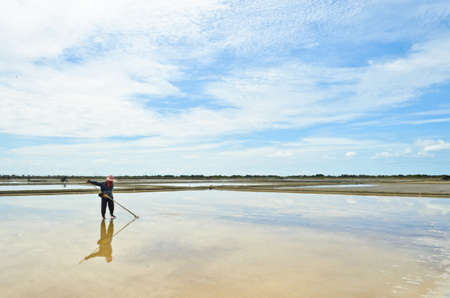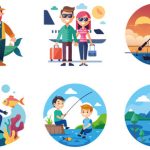Introduction to America’s Hidden Fishing Gems
When most anglers think of freshwater fishing in the U.S., places like Lake Okeechobee, Lake Michigan, or the Mississippi River often come to mind. But beyond these well-known spots lies a world of hidden gems—lesser-known lakes, creeks, and rivers that offer incredible fishing experiences without the crowds. These off-the-beaten-path locations not only provide peaceful surroundings but also the chance to catch species in waters that are often underfished.
Why Explore Lesser-Known Fishing Spots?
Fishing in remote or lesser-known areas can be a game changer for anglers looking for something different. These spots often feature untouched natural beauty, more relaxed regulations, and unique fishing opportunities. Whether youre casting from a kayak in a quiet mountain lake or fly fishing in a secluded Appalachian stream, there’s something special about exploring these hidden treasures.
Benefits of Fishing Off the Beaten Path
| Benefit | Description |
|---|---|
| Less Competition | Fewer anglers mean less pressure on fish populations and better chances of success. |
| Scenic Surroundings | These spots are often located in pristine natural settings away from urban noise. |
| Diverse Species | You might find fish not commonly targeted in more popular locations. |
| Adventure Factor | Exploring new territory adds excitement and satisfaction to your fishing journey. |
How They Differ from Popular Destinations
Lesser-known fishing locations differ from mainstream spots in more ways than just size or popularity. Many of them don’t have developed boat ramps, bait shops, or even cell service—but what they lack in convenience they make up for in experience. These places call for a bit more preparation and a spirit of adventure, making them ideal for anglers who enjoy going beyond the ordinary.
Popular vs. Hidden: A Quick Comparison
| Feature | Popular Locations | Hidden Gems |
|---|---|---|
| Crowd Level | High – especially during weekends and holidays | Low – peaceful and uncrowded year-round |
| Amenities | Well-developed with facilities and services | Minimal or none – requires self-sufficiency |
| Fish Pressure | Often heavily fished with educated fish | Lighter pressure – more aggressive bites possible |
| Accessibility | Easily accessible by car or boat ramp | Might require hiking, paddling, or off-road travel |
If you’re ready to discover fresh waters filled with promise and peace, these hidden locations across America offer an unforgettable angling experience far from the usual crowd.
2. Backcountry Lakes and Remote Reservoirs
For those looking to escape the crowds and dive into the heart of nature, backcountry lakes and remote reservoirs in states like Montana, Idaho, and Arkansas offer some of the most rewarding freshwater fishing experiences in the U.S. These off-the-beaten-path locations are not only peaceful but also packed with opportunities for landing impressive catches.
Why Go Off-Grid?
Fishing in secluded spots means less competition, more wildlife sightings, and a deeper connection with nature. Whether you’re casting from a kayak or hiking into high-mountain waters, these destinations provide solitude that’s hard to find at popular fishing holes.
Top Remote Fishing Spots by State
| State | Location | Target Species | Access Type |
|---|---|---|---|
| Montana | Hidden Lake (Glacier National Park) | Cutthroat Trout | Hiking Only |
| Idaho | Deadwood Reservoir | Kokanee Salmon, Rainbow Trout | Backroad Vehicle Access |
| Arkansas | Lake Sylvia | Largemouth Bass, Bluegill | Primitive Road Access + Short Hike |
What to Bring on a Remote Fishing Trip
- Lightweight Gear: A compact spinning rod or travel fly rod works best when hiking in.
- Navigation Tools: GPS or map and compass—cell service is often unreliable in backcountry areas.
- Packing Essentials: Don’t forget water, snacks, first-aid kit, and bug spray.
- Tackle Selection: Match your lures or flies to the local species—small spoons, jigs, or dry flies work well depending on location.
Tips for Success
- Check Local Regulations: Some remote areas have special rules or require permits.
- Time It Right: Early mornings or evenings often bring the best bite—and cooler temps for hiking.
- Leave No Trace: Pack out everything you bring in and respect the natural environment.
A Hidden Gem Worth Exploring
If youre up for an adventure, try exploring Montana’s Beartooth Plateau. With hundreds of alpine lakes accessible by trail, it’s a paradise for anglers chasing native trout in crystal-clear waters surrounded by rugged peaks. Just be sure to bring your bear spray!
The Reward of Going Remote
The beauty of fishing these lesser-known waters is not just in the catch—it’s in the experience. Quiet mornings, untouched landscapes, and the thrill of discovering your own secret spot make every trip memorable. For anglers willing to put in a little extra effort, America’s remote freshwater gems are waiting to be discovered.

3. Unknown Rivers with Big Potential
While many anglers flock to well-known rivers like the Mississippi or Columbia, some of the best freshwater fishing in America can be found in lesser-known rivers tucked away across the country. These hidden gems offer not only fewer crowds but also surprising diversity in fish species and exciting opportunities for both novice and seasoned anglers.
Hidden River Hotspots Worth Exploring
Here are a few under-the-radar rivers that pack a serious punch when it comes to freshwater fishing:
| River Name | Location | Target Species | Best Techniques |
|---|---|---|---|
| Flint River | Georgia | Shoal Bass, Catfish, Bream | Topwater lures, live bait drifting, fly fishing |
| St. Croix River | Minnesota/Wisconsin Border | Smallmouth Bass, Walleye, Northern Pike | Casting jigs near structure, trolling crankbaits |
| John Day River | Oregon | Smallmouth Bass, Chinook Salmon (seasonal) | Soft plastics, spinnerbaits, fly fishing for bass |
| Green River | Utah/Kentucky (two different rivers) | Trout (UT), Largemouth Bass & Crappie (KY) | Nymphing (UT), jigging and slow rolling (KY) |
Why These Rivers Are Special
A big part of what makes these rivers so appealing is their relative isolation. With less fishing pressure compared to major waterways, fish populations often thrive undisturbed. Additionally, these rivers flow through diverse landscapes—from Appalachian foothills to high desert canyons—offering a peaceful setting and plenty of adventure beyond just fishing.
Tips for Fishing Remote Rivers
- Do your homework: Local bait shops and conservation websites are goldmines for info on seasonal bites and access points.
- Pack smart: Bring versatile gear since water conditions can vary greatly along remote stretches.
- Go light and mobile: Kayaks or small jon boats are perfect for navigating shallow or narrow spots.
- Respect local regulations: Some of these spots may have special rules or catch limits to protect native species.
The Joy of Discovery
The thrill of exploring new waters and uncovering hidden fisheries is one of the great joys of angling. Whether youre chasing trophy smallmouth in Oregon’s John Day or hooking into shoal bass on Georgia’s Flint River, these lesser-known rivers prove that sometimes the best fishing isn’t where everyone else is—it’s off the beaten path.
4. Fishing Local: Small Town Secrets
When it comes to freshwater fishing, some of the best spots aren’t found on popular travel blogs or national park maps—theyre hidden in small towns across America. These off-the-radar communities are home to rich angling traditions, local know-how, and some seriously good fishing that most outsiders never hear about.
Where Community Meets the Water
Small towns often have a deep connection to nearby lakes, rivers, and creeks. The locals grow up fishing these waters, passing down tips and techniques from one generation to the next. Whether youre chatting with a bait shop owner or sharing a dock with a lifelong resident, youll find that hospitality runs as deep as the water itself.
Hidden Gems by Region
Every region has its own flavor of fishing, shaped by geography, climate, and culture. Heres a look at a few lesser-known small-town fishing destinations worth exploring:
| Region | Town | Waterbody | Local Highlight |
|---|---|---|---|
| Southeast | Bainbridge, GA | Flint River | Trophy bass and friendly mom-and-pop tackle shops |
| Midwest | Potosi, WI | Mississippi River backwaters | Largemouth bass and regional fish fries |
| Northeast | Ticonderoga, NY | Lake Champlain | Diverse fish species and colonial town charm |
| Pacific Northwest | Kettle Falls, WA | Kettle River & Lake Roosevelt | Crisp mountain air and walleye hotspots |
| Southwest | Payson, AZ | Mogollon Rim lakes | Trout-filled high country lakes with rustic cabins nearby |
The Charm of Local Flavor
A big part of what makes these towns special isn’t just the fishing—it’s the experience. Grab breakfast at the local diner before heading out on the water. Swap stories with fellow anglers at the gas station while you fuel up. These places offer more than just fish; they offer connection.
Bait Shops Are Goldmines of Info
If you want to fish like a local, talk to a local. Small-town bait shops are more than just supply stops—they’re gathering spots for real-time fishing reports and expert advice. Don’t be shy about asking which lures are hot or where the bite’s been strong lately.
A Few Tips for Fishing in Small Towns:
- Be respectful of private property—ask if youre unsure.
- If invited to join a local event or derby, go! It’s a great way to meet people.
- Treat these quiet places gently—pack out what you pack in.
The heart of American freshwater fishing beats strongest in its smallest communities. If youre willing to wander off the beaten path, youll not only catch fish—you’ll find stories worth remembering.
5. Tips for Off-the-Grid Fishing Adventures
Fishing in remote, lesser-known freshwater spots across the U.S. can be incredibly rewarding—but it takes a bit more planning and preparation than your average weekend trip. Here’s what you need to know before heading off the beaten path.
Gear Essentials for Remote Fishing Trips
When youre far from tackle shops or cell service, having the right gear can make or break your adventure. Here’s a quick checklist of must-have items:
| Category | Recommended Gear |
|---|---|
| Fishing Equipment | Medium-action rod, spinning reel, versatile lures (spoons, soft plastics), extra line, compact tackle box |
| Camping Essentials | Tent or hammock with bug net, sleeping bag rated for local climate, portable stove or fire-starting kit |
| Navigation & Communication | Topographic maps, GPS device or offline map app, satellite phone or personal locator beacon (PLB) |
| Safety Gear | First-aid kit, bear spray (in certain regions), water purification tablets or filter, headlamp with extra batteries |
Plan Ahead and Stay Safe
Before heading into remote areas, always let someone know where youre going and when you plan to return. Check the weather forecast and understand any specific risks in the area—such as flash floods in desert canyons or hypothermia risks in high-altitude lakes.
Permits and Regulations
Many off-the-grid fishing spots are located on public lands managed by agencies like the U.S. Forest Service or Bureau of Land Management. Always check if you need:
- A state-issued fishing license (required in all states)
- Special permits for wilderness access or backcountry camping
- Catch-and-release regulations or species-specific rules
Respecting Nature and Local Communities
Preserving these hidden gems means practicing Leave No Trace principles. Pack out everything you bring in—including fishing line and food wrappers—and avoid disturbing wildlife. If youre near Indigenous lands or small rural communities, be mindful of local customs and private property boundaries.
Quick Dos and Donts for Responsible Anglers
| Do | Dont |
|---|---|
| Use barbless hooks to minimize fish injury | Leave trash or bait containers behind |
| Follow posted signs and respect closed areas | Trespass on private land without permission |
| Practice ethical catch-and-release techniques | Introduce non-native baitfish into new waters |
The more prepared you are, the more you’ll enjoy your off-the-grid fishing trip—and the better chance we all have of keeping these places wild and beautiful for generations to come.


